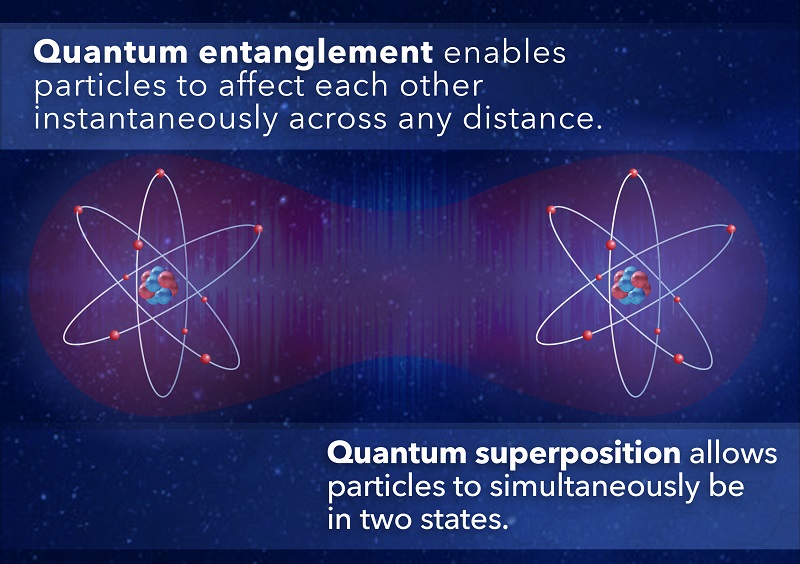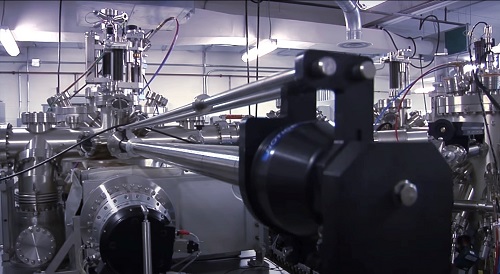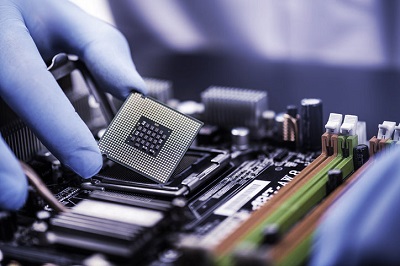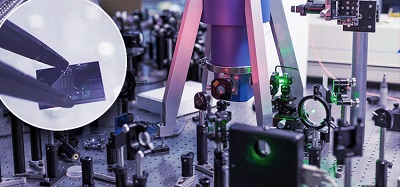Introduction
Quantum mechanics has been around for more than a century and is recognized as the most significant and successful theory in modern physics.
Figure 1

Quantum entanglement enables particles to affect each other instantaneously across any distance.
Quantum superposition allows particle to simultaneously be in two states
Nevertheless, quantum remained in obscurity for many decades primarily because of its counter-intuitive foundational principles, the complexity in performing experiments, and the difficulty in communicating its properties using non-technical jargon. It has been said that the two most important and perplexing properties of quantum mechanics, superposition and entanglement [See Figure 1], can only be precisely and accurately described using the language of mathematics. These two properties, however,
underpin technologies that proved to be disruptive in the past and are anticipated to be disruptive to in the future.
Quantum 1.0
The first generation of quantum devices revolutionized defence and security capabilities and transformed society. The two most salient examples of technologies that are fundamentally reliant on the effects of quantum mechanics, technologies now known as Quantum 1.0, [1] are the transistor and the laser, which form the foundation of our modern digital age and are key enablers of a range of technologies [See Box 1].
|
a) |
Box 1 a) The first quantum revolution gave us new rules that govern reality. A transformative example of such a harnessed physical description led to lasers, circuit boards, and silicon-based electronics. b) The second quantum revolution allowed for the precise control and manipulation of these quantum properties of light and matter which are entering the engineering stage of applications. |
|
b) |
|
In the past decade quantum has become an enthusiastically discussed topic in popular science and, thanks primarily to the public attention surrounding quantum computing, has entered the vernacular. The first generation of quantum technologies have continued their rapid development and have, in turn, become key enablers for the engineering advances required to bring about the next quantum revolution.
Quantum 2.0
A new generation of technologies, Quantum 2.0, has emerged over the last fifteen years due to more controlled isolation and manipulation of delicate quantum systems. Quantum 2.0 is defined as “a class of devices that actively create, manipulate and read out quantum states of matter, often using the quantum effects of superposition and entanglement” [1]. Quantum 2.0 systems can include materials constructed with atomic precision, the creation and stabilization of subtle states of matter using highly precise lasers, or the encoding of information onto atoms and single photons of light. These systems are unique in their ability to leverage and control previously inaccessible properties of nature, allowing for stunning new capabilities such as quantum computers that can quickly solve certain types of problems that a classical computer cannot.
Currently, most quantum proof-of-principle and early-stage engineering applications reside in university laboratories and the National Research Council Canada (NRC), requiring expensive infrastructure, specialised equipment, teams of experts, and large footprints to operate. However, in some technology areas where defence departments have begun investing, the transition of Quantum 2.0 technologies out of the laboratories and towards prototypes has begun.

Credit: University of Waterloo
Quantum for Defence and Security
Quantum technologies will deliver significant capability enhancement in areas of known defence and security interest. The areas that will likely see the greatest disruption across the quantum technological landscape are sensing [including Positioning, Navigation and Timing (PNT)], communications, computing, and the development of new materials. At the same time, the ability of adversaries to exploit quantum technologies for their aims will affect the tactics, techniques, and procedures that the Defence Team must employ to achieve its mission. Quantum sensing serves as a salient example of the breadth and utility of quantum applications that currently exist at low technology readiness levels and that are uniquely positioned to impact the defence and security landscape in the next five years. Quantum systems are easily perturbed and therefore ideally suited for core defence and security sensing applications. Traces of electric and magnetic fields, gravitational variations, vibrations, or motion are detectable by quantum systems at levels unachievable by classical systems. Transition of these technologies out of the lab will lead to capabilities such as: Gravimetric sensors that can detect tunnels or objects behind walls;
- Compact, wide-band electromagnetic sensors that outperform and replace multiple antenna systems;
- Stealth-defeating radar that is difficult to detect and jam;
- Precise and covert range-finding techniques that can see through smoke and around corners;
- Detection of trace levels of chemicals and radiation at sensitivities and distances not possible with existing techniques; and
- Compact inertial sensors and clocks that can maintain sufficient accuracy for Defence to complete its missions in Global Positioning System (GPS)-denied environments, including underwater and underground.
Some of these potential capabilities could provide solutions to new and emerging defence challenges, such as the need for greater surveillance over the vast Canadian Arctic and the aerospace and maritime approaches to Canada and North America. The wide potential application of quantum technologies means it may deliver surveillance capabilities across domains and as part of a layered “system of systems” to provide the CAF and North American Aerospace Defense (NORAD) with innovative all-domain awareness capabilities.Quantum sensing is not alone in its applicability to defence and security. For example, quantum communications will bring capabilities such as covert communications, anti-spoofing, jamming resistance, and secure key distribution. Quantum computing promises the ability to solve certain types of problems that cannot be solved on a classical computer, such as optimization-based logistics and the breaking of most currently implemented cryptographic protocols. For all quantum technologies, the transition path out of the lab, into prototypes, and towards fieldable equipment remains a complex scientific and engineering problem. Presently, the ability to transition quantum technologies to higher technology readiness levels (TRLs) is an area of global competition which underscores the need to protect Canadian research and innovation in the field. The defence and security applications of quantum technologies have been recognized by a number of other nations; the United States, United Kingdom, Germany, and China have already launched large-scale national quantum strategies that are coupled to their defence interests. China, in particular, has risen into the ranks of the world leaders in quantum S&T and has invested heavily in areas that promise to deliver new and enhanced military capabilities. Assuring and countering such capabilities is a concern unique to Defence.
The Canadian Quantum Landscape
Canadian foundational quantum research—fueled by early federal, provincial, and philanthropic investment—has positioned Canada as a leader on the international scale. Quantum science is a fixture in the national science and technology strategy, Seizing Canada's Moment: Moving Forward in Science, Technology and Innovation (2014) [2] and quantum computing has been named one of the digital focus areas of the national innovation agenda, Canada: A Nation of Innovators (2016) [3]. Such academic quantum research excellence and expertise coupled with Canada’s thriving technology entrepreneurship [4] point to a promising environment for leading edge quantum innovation.
Canada stands to gain much from its heritage in the development of quantum technologies. It is projected that by 2040 the up-and-coming quantum industry sector will be a strong contributor to the Canadian economy (between 1.7% and 3.4% Gross Domestic Product (GDP)). The sector’s projected revenues are expected to match what the aerospace sector, Canada’s most Research and Development (R&D) intensive industry, contributes to the national economy today. However, this rapid technology pace also points to labour shortages in quantum-trained, broadly-skilled personnel both in Canadian industry and government and also around the world [5].
J. P. Dowling and G. J. Milburn, Quantum Technology: The Second Quantum Revolution, 2002. Ultimately, all of nature relies on the fundamentals of quantum mechanics, but if a technology can be sufficiently described using the laws of classical (pre-quantum) physics it is not considered part of Quantum 1.0.

